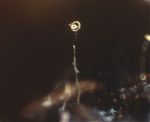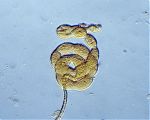Helicocephalum
HELICOCEPHALUM Thaxter, 1891 [Botanical Gazette (Crawfordsville) 16: 201]; 5 species ( Thaxter, 1891).
Parasites of small animals, especially nematodes and nematode eggs. Vegetative hyphae relatively thin, coenocytic. Sporangiophores with a basal holdfast and an apex that coils or less commonly remains straight and becomes moniliform; septa produced at constrictions, spores arthrospores. Spores long-ellipsoid to doliiform, relatively large, pigmented, unicelled, terminal spore truncate on basal end, other spores truncate in both ends. Spores released in a droplet of fluid at maturity, remaining in a mass when droplet dries. Zygospores unknown.
Type species: H. sarcophilum
Species of Helicocephalum:
H. africanum C. Roux, 1996 (South African Journal of Botany 62:104) (Roux, 1996a, 1996b; Roux and Botha, 1995).
H. corniculatum Kitz & Embree, 1989 (Mycologia 81:164) (Kitz and Embree, 1989).
H. diplosporum Drechsler, 1943 (Mycologia 35:140) (Drechsler, 1943)
H. oligosporum Drechsler, 1934 (Mycologia 26:35) (Drechsler, 1934; Barron, 1975; Watanabe and Koizumi, 1976).
H. sarcophilum Thaxter, 1891 [Botanical Gazette (Crawfordsville) 16:201] (Martin, 1937; O’Donnell, 1979; Thaxter, 1891).
Possible additional species of Helicocephalum:
H. megalosporum G. Arnaud, 1952 (Bull. Soc. Mycol. France 68:208)—nomen nudum, without a Latin diagnosis but possibly a Helicocephalum. (Arnaud, 1952).
Helicoon ovalisporum Krzemieniewska & Badura, 1954 (Acta Soc. Bot. Polon 69:294) (Krzemieniewska and Badura, 1954—possible additional Helicocephalum; Goos et al., 1986).
Possible helicosporous deuteromycete:
H. sarcophilum Thaxter var. β G. Arnaud, 1952 (Bull. Soc. Mycol. France 68:207—nomem nudum, without a Latin diagnosis)—probably a helicosporous deuteromycete (Arnaud, 1952).
H. tennellum Boroska, 1997 (Acta Mycologica 32:129) (Borowska, 1997—a helicosporus hyphomycete?)
Species of Helicocephalum are not reported in the literature often and new taxa are rarely described. Helicocephalum spp. can be confused with helicosporous deuteromycetes (Goos et al., 1986). The best descriptions and illustrations of Helicocephalum can be found in Thaxter (1891), Drechsler (1934, 1943), and Barron (1975). Helicocephalum diplosporum (Drechsler, 1943) is unusual because the sporangiophore apex remains straight and only two spores are produced. In the remaining species of Helicocephalum, H. africanum, H. corniculatum, H. oligosporum, H. sarcophilum (Thaxter, 1891; Drechsler, 1934; Kitz and Embree, 1989; Roux, 1996a) the apex is coiled and (1-)3-20 or more spores are formed.
The best habitat for Helicocephalum spp. would be where members of the Cochlonemataceae (q.v.) and Zoopagaceae (q.v.) also occur. The hosts for species of Helicocephalum are nematodes and nematode eggs. Barron (2004) described the methods he recommends for collecting fungal parasities of amoebae, nematodes, rotifers and other small animals, and also for cultivating the hosts.
Bibliography
Arnaud, G. 1952. Mycologie concrète : genera. Bull. Soc. Mycol. France 68:181-223.
Barron, G.L. 1975. Nematophagus fungi: Helicocephalum. Trans. Brit. Mycol. Soc. 65: 309-310.
Barron, G.L. 2004. Fungal parasites and predators of rotifers, nematodes, and other invertebrates, pp. 435-450. In: G.M. Mueller, G.F. Bills, and M.S. Foster (eds.). Biodiversity of fungi. Inventory and monitoring methods. Elsevier Academic Press. Amsterdam, The Netherlands.
Borowska, A.A. 1997. A new species of Helicocephalum from Poland. Acta Mycologica 32:129-131.
Drechsler, C. 1934. A new species of Helicocephalum. Mycologia 26: 33-37.
Drechsler, C. 1943. A new non-helicoid bisporus Helicocephalum parasitizing nematode eggs. Mycologia 35: 134-141.
Goos, R.D., S.K. Abdullah, P.J. Fisher, and J. Webster. 1986. The anamorph genus Helicoon. Transactions of the British Mycological Society 87:115-122.
Kitz, D.J. and R.W. Embree. 1989. A new species of Helicocephalum from Iowa. Mycologia 81: 164-166.
Krzemieniewska, H., and L. Badura. 1954. A contribution to the knowledge of the microorganisms from the litter and soil of the beech-wood. Acta Societatis Botanicorum Polaniae 23:727-776.
Martin, G.W. 1937. Notes on Iowa fungi. VII. Proceedings of the Iowa Academy of Science 44:45-53.
Roux, C. 1996a. A new species of Heli[c]ocephalum (Zygomycotina) from South Africa. South African Journal of Botany 62:104-107.
Roux, C. 1996b. A new species of Helicocephalum (Zygomycotina) from South Africa. South African Journal of Botany 62:285.
Roux, C., and A. Botha. 1995. Helicocephalum sp.: Zoopagales from Hyrax dung. Electron Microscopy Society of Southern Africa – Proceedings 25:40.
Thaxter, R. 1891. On certain new or peculiar North American Hyphomycetes. II. Helicocephalum, Gonatorrhodiella, Desmidiospora nov. genera and Everhartia lignatilis n. sp. Bot. Gaz. (Crawfordsville) 16:201-205.
Watanabe, T., and S. Koizumi. 1976. Materials for the fungus flora of Japan (20). Trans. Mycol. Soc. Japan 17: 1-3.
Updated Apr 09, 2007


